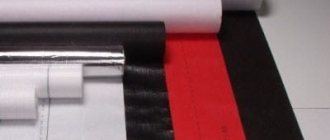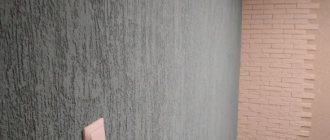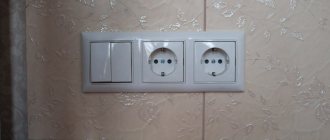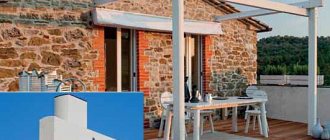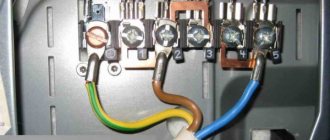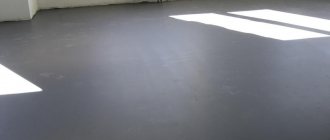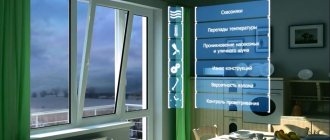High-quality and reliable sound insulation is an important component of coziness and comfort for people’s living, both in private and apartment buildings. During the construction stage, specialists install special materials in the walls that can absorb noise, but in 95% of cases the discomfort remains. The reason for this is poor-quality sound insulation carried out in electrical points.
Typical socket installed in homes
Additional insulation of sounds and noise in the apartment
Paying maximum attention to the soundproofing of walls, floors or ceilings, room owners simply forget about the process of soundproofing in the openings for sockets and switches. Meanwhile, such an oversight threatens to nullify all work on soundproofing housing. Why is it so necessary to install insulating materials in sockets and switches, at what stage can they be carried out, and is it worth doing it yourself? 5% of premises in new buildings have soundproofed sockets. Speaking of old panel houses, this figure is “0”.
Peculiarities
The production of reinforced concrete slabs involves the formation of leaking cracks to simplify the work of electricians. Repairers provide them with multiple power cords. Connect a couple of hidden-mounted sockets in neighboring apartments. Sometimes they don't care about a basic gasket with soundproofing results.
Tenants have to eliminate this imperfection of a standard building on their own, otherwise their comfort will be constantly disturbed and not always only against the background of the noise of neighbors. The air duct constantly sucks unpleasant odors, allergens, tobacco smoke and germs into the apartment. You can make soundproof sockets yourself, or you can use the services of specialists.
Upon closer examination, it turns out that the problem can be solved in one of the following ways:
- lay a soundproofing base under the exit.
- move the built-in socket to a more suitable place;
- change the socket in the delivery note;
A hidden, internal or built-in outlet is a wall outlet. On the outside there is only a decorative and protective ceiling console. Built-in sockets are used when disassembling hidden wiring. Strobing them is a painstaking task, even if they seem neater. You can move the hidden handle by drilling another hole next to the old one and making a groove for the wire.
An outdoor receptacle is mounted above the wall surface for external wiring. Its mini-body rises by 5 cm, but in new buildings this is not always necessary. When repairs are not planned, it is more profitable and economical to soundproof the existing hidden electrical outlet. This is not as difficult as it seems: the socket and box are removed from the socket hole, the soundproofing base is inserted into the socket and the structure is installed in place.
Why do they do this?
Many apartments in high-rise buildings are built in such a way as to minimize the load of interior walls on the supporting structures of the house. Also, in order to save money, a through socket is often used for several rooms or apartments at once. In this case, isolation is not used, and, as a result, neighbors live in different rooms, but even know about each other’s conversation. In order to create comfortable conditions, as well as in view of other advantages, measures are taken to soundproof sockets, including.
Other advantages and objectives of soundproofing a wall socket connector:
- Preventing the smell and smoke from smoking from entering the apartment.
- Establishing the process of air microcirculation, which is important in rooms with centralized air outlets.
- Preventing insects from neighbors, spiders and cockroaches.
Soundproofing of joints, windows and doors
Soundproofing of joints between slabs is carried out with conventional putty mixtures. All detected cracks and defects must first be expanded using a screwdriver or chisel. Then the cracks are cleaned of dust and sand, primed and covered with putty. When the putty mixture has dried, the joint surface is covered with acrylic sealant.
Modern double-glazed windows with triple glazing are well protected from street noise. All cracks between the wall and the glass unit must be carefully insulated with polyurethane foam. If the window has lost its seal, it’s worth taking the risk and applying sealant. Install PVC strips and strips if necessary.
The door is insulated along the entire perimeter with special rubber seals. The space between the opening and the door frame must be sealed with cement mortar.
How to soundproof an outlet in an apartment with your own hands
You can carry out work on soundproofing a hole in the wall yourself in several ways:
- moving an already built-in socket;
- installation of an overhead socket or replacement with a new invoice;
- installation of a soundproofing layer without replacement or transfer.
The transfer method is carried out both in old residential buildings and in new buildings. Used when it is necessary to change the space or subsequent zoning during redevelopment. The transfer will improve ergonomics while increasing comfort. Since the sockets are different, the methods for soundproofing them differ.
Through
A socket that is installed in one wall between two rooms or apartments and has one hole is called through. Panel houses face this problem and conflicts often arise between neighbors. Therefore, it is important to soundproof the through socket and do it efficiently.
For example, using construction foam to blow in and secure a niche is impractical and ineffective for several reasons:
- foam has low sound absorption and sound insulation;
- the material is not resistant to high temperatures;
- the swollen foam will probably pass through the holes, getting to the neighbors, hardly anyone will like this;
- foam weakly eliminates drafts.
Therefore, the use of fiberglass, cement mortar or basalt cardboard will be much better.
To carry out the work, you should pay attention to glass wool, it is the most practical, and its soundproofing properties perfectly absorb sounds. When soundproofing an outlet with mineral wool, you should do the following manipulations:
- Cut a circle with a diameter of 50 mm, and it is worth calculating the diameter of the circle so that it is 2-3 mm. Wider than the hole being processed in the wall
- Press the circle of mineral wool tightly with your fingers, inserting it into the depth of the hole.
- If the gap between the neighboring rosette is less than 5 cm, take 10 mm of basalt cardboard, having previously cut out 2-4 circles from it.
- Next, work is carried out to install the socket box and socket.
Building slabs made of reinforced concrete for high-rise buildings are 12-15 cm thick. With a depth of immersion into the hole of 8 cm. Of these 8 cm, 4.5 will be filled by the installation box. This should be taken into account when filling the opening with soundproofing material.
Hidden with niche
If you need to soundproof a hidden outlet, you should decide on the option for its subsequent location. If you need to change the location, then noise insulation is carried out with transfer. Otherwise, no transfer.
When you need to replace a built-in outlet with a surface-mounted one, it is important to be patient. For the correct sequence of work, fill the recess in the wall with the solution, wait for it to dry, and only then install a new socket. If you want the new outlet to be hidden, you first need to make a groove at the base of the wall for the wiring and outlet.
The nature of the methods and materials used for soundproofing inter-apartment outlets is determined by the capabilities of the apartment owner: basalt materials, rolled materials, corrugated cardboard or mineral wool. The process of laying the material is similar to the algorithm given earlier.
Invoice
Installing an overhead socket allows you to hide most of it, including the wires, but a decorative cover without holes will be visible deep in the wall. Soundproofing work will help reduce noise by 70%.
To make a surface-mounted socket, you need to drill holes next to the existing ones, make a container in the wall according to the size and lay the wire, covering it with a special cover. An external socket is installed in houses with open wiring; it is an outdated option and is used more often for vintage style.
Sequence of work:
- de-energizing the socket;
- removing the box (socket box) from the previous nest;
- laying soundproofing material in the hole, preferably basalt wool, corrugated cardboard or plasterboard;
- installation of the socket box and socket in the previous place.
Safety precautions
Work with sockets involves electrical wiring and therefore, first of all, must be carried out in accordance with electrical safety requirements. To do this, the following steps must be performed:
- De-energize the apartment by turning off the electricity supply from the distribution panel or from the meter.
- Make sure the power is turned off using an indicator screwdriver or multimeter.
- Only after the instrument readings show no voltage can you begin to dismantle the outlet.
- After the socket box is removed and the wires are disconnected from the terminals, they must be carefully wrapped with electrical tape.
- When using wet construction soundproofing mixtures to prevent water ingress and short circuits, it is necessary to protect the neighbor's outlet. This can be done by installing a plastic gasket. To protect your outlet from moisture, you must wait until the mixture has completely dried before continuing to work.
- If possible, warn neighbors about the work if the hole is through. In this case, you can protect yourself if you use your neighbor’s outlet during installation work.
In general, it is advisable to have skills in handling electrical wiring or invite a specialist to carry out such work.
The best materials for do-it-yourself soundproofing a niche
To ensure maximum noise insulation from neighbors in the outlet, it is worth using materials that absorb the largest percentage of noise.
Based on the nature of sound absorption, materials are classified into porous, membrane, and perforated. According to appearance and technology - roll, tile or liquid. The sound insulation index Rw (or airborne noise) is an integral characteristic applied exclusively to the frequency range of about 100-3000 Hz. In addition, this range is designed to assess noise of a domestic nature: conversation, music, TV. It is noteworthy that the higher the airborne noise value, the higher the noise insulation of a particular type.
To choose the right material, you should pay attention to the degree of sound absorption:
- mineral wool and membrane materials – sound absorption 80-95%;
- cork covering – 70%;
- gypsum – 60%;
- corrugated cardboard in one layer - 40%, the more there are, the higher the sound insulation.
Basalt wool and cardboard
Mineral wool or thick cardboard are professional building materials that allow you to achieve a high degree of sound absorption. The quality of sound insulation will be high, and the expensive cost of the material is compensated by fire safety. A piece of basalt material is also cut out with a margin of 2-4 mm larger than the diameter of the socket. During installation, slightly compress the material from the edges, then insert it into the desired hole for the socket.
Plasterboard and gypsum fiber sheets
A simple and inexpensive option is to use drywall. To carry out the work, you will need the remainder of the previously used material, which was used to level, for example, walls or partitions. The material does not allow sounds, dust, dirt, or foreign odors to penetrate.
Membrane materials
Acoustic boards are among the materials that are most often used for soundproofing walls in music schools. Synthetic binders with fibrous fillers (in this case, glass mineral wool) have an average density of up to 140 kg/m3, covered with a decorative coating layer. They are also often used as finishing material for ceilings, lobbies or concert halls, and radio studios. Sound absorption coefficient - 50-2000 Hz with a thickness of 0.40-0.47 (tensile strength 0.3-0.4 MPa). Since such material is not sold in small quantities, it can be used to soundproof in case of residues when soundproofing a large area.
Loaded Vinyl
The soundproofing membrane, whose thickness is only 3 mm, is loaded vinyl, has excellent soundproofing properties, is easily attached to the surface, and replaces several centimeters, for example, of the same fiberglass. If you need to soundproof a thin partition wall between rooms or a through socket, then this material is most relevant.
Thermosound insulation (TSI) is also considered an effective material. It reduces acoustic sound by four times and vibration noise by 12 times.
Application of the solution
If you don’t have any of the above materials at hand, use the optimal soundproofing method - cement-sand mortar or
special soundproofing putty.
In this case, you will need to strengthen the base of the socket box, tighten the wires, and fill the resulting containers with liquid solution. After complete drying, finishing and decorative work is carried out.
Special ready-to-use soundproofing socket boxes of the “SoundGuard” and “TichoBlock” types are sold. Such inserts are a rectangular or square-shaped frame of the socket box, which is made from multi-layer cardboard. This cellular cardboard is filled with quartz sand mixed with silicone filler.
Reasons for poor sound insulation of panel houses
There are several reasons why panel houses cannot boast of good insulation from airborne and impact noise:
- violations during the installation of window and door frames, as a result of which their tightness is reduced.
- poor design of the body, which leads to poor joining of panels, cracks and distortions;
- low quality of construction and repair work, the presence of leaky seams and gaps between the slabs;
- non-compliance with the technology for installing interior and interior partitions;
- the use of cheap and low-quality sound-absorbing materials;
- non-compliance with the rules for the thickness of floors and partitions;
- illegal redevelopment of an apartment by neighbors in violation of SNiP;
The main reason for poor sound insulation is the desire of developers to save money on building construction, primarily on sound insulation. Its quality cannot be assessed without special equipment and the involvement of specialists, and the percentage of savings for the developer on soundproofing materials will be up to 40%.
Source – https://mr-build.ru/noise/zvukoizolacia-rozetok.html
What materials cannot be used to soundproof sockets?
Experts are unanimous on one thing - the use of construction foam for soundproofing or fixing sockets is unacceptable.
Even fireproof foam cannot withstand temperatures exceeding 90 degrees.
In addition, you should not use ordinary corrugated cardboard for sound insulation, which is also a fire hazardous material.
Do not confuse corrugated basalt cardboard with regular cardboard. The latter ignites when shorted, creating a fire hazard in the house.
If they want to soundproof a room, homeowners forget about the need to insulate sockets that transmit noise and extraneous sounds from neighboring apartments. Therefore, when installing new outlets or repairing old ones, it is important to pay attention to the quality of the work. If necessary, you can take ready-made blocks for socket boxes, or carry out the work yourself using the most convenient materials.
Soundproofing of central heating risers
According to regulations, central heating pipes passing through ceilings must be laid in special couplings. These are large diameter pipes that perform the function of sound insulation. If the rules are not followed and the sleeve is missing, then the owners will have to insulate the risers themselves.
- Remove the grout from around the pipe.
- Wrap the free tube in mineral or glass wool.
- Cement the space between the pipe, ceiling and insulation.
- Cut out any remaining sound-absorbing material.
- Gently rub the surface and smooth out any uneven surfaces.
Soundproofing substrates
This group of building products allows you to increase the insulating properties of the coating in a panel house without completely dismantling existing structures. Due to their small thickness, the materials do not cause the floor level to rise above the permissible level. Depending on the type of finishing layer, acceptable height, and acoustic characteristics of the substrate, a product with suitable parameters is selected.
Roll and slab substrates based on natural cork are popular. In addition to environmental friendliness, durability, and immunity to moisture, they successfully combine low thermal conductivity with the ability to absorb acoustic vibrations. A tangible result is achieved by using modern multi-layer products, for example, a felt coating reinforced with a polymer base.
Natural cork backing.
Cheap and relatively effective materials include substrates made of soft wood-fiber boards; despite the name, the material is not subject to deformation, maintaining its original thickness under load, which allows it to be used under type-setting and panel parquet and laminated coverings. The choice of soundproofing substrates in the retail chain is significant; manufacturers are constantly expanding their range of products, but when purchasing them, one must not forget that, despite advertising promises, the capabilities of thin materials are limited, although often sufficient.
Soundproofing the floor
The first step is to remove the skirting boards that surround the floor. Remove them carefully so as not to damage them, as they will then be installed in their original place. If the flooring is an old budget material, for example, linoleum, sound insulation can be done on top of it.
The new covering is dismantled, and after the soundproofing work is completed, it is laid again.
Soundproofing a floor begins with a layer of fiberglass flooring. Be sure to wear gloves and take care of eye protection. This material consists of tiny fibers that have an irritating effect on the skin.
Wood blocks are laid on the fiberglass layer at a distance identical to the width of the insulating boards, leaving a margin between the tips and walls.
Wooden blocks do not need to be fastened - rigid fasteners will allow noise to be transmitted through the wood, since its sound absorption level is low.
The next step is laying mineral wool in strips between the wooden elements and sealing with gypsum fiber boards, which are laid in a double layer.
Important! Lay the joints between the slabs and the walls with sound-absorbing tape. All that remains is to lay the finishing coating of your choice on the rough soundproofed floor
All that remains is to lay the finishing coating of your choice on the rough soundproofed floor.
Conclusion
An integrated approach, specialized materials and correct installation are the key to long-awaited peace of mind. It is almost impossible to completely eliminate extraneous noise, but the proposed solutions will help reduce their level to a comfortable minimum.
On the topic, it is useful to read material about local sound insulation of the ceiling. Decorative noise-absorbing panels will help to muffle irritating sounds somewhat. The video is about a house using LSTK technology, in which everything is in order with sound insulation.
Subscribe to our Telegram channelExclusive posts every week
Building types
Frame-monolithic buildings (monolithic houses) have gained recognition due to the simplicity and high speed of their construction. Apartments there are inexpensive due to the cost-effective construction technology. The price is also reduced by the fact that most of them are usually sold “for repairs”. This means that a new resident of a monolithic house receives the frame of his home, consisting of walls, columns, ceiling and floor (in the best case with a poured screed), and has the right to manage the layout and decoration of the future apartment at his own discretion.
Indeed, it is very convenient, but the sound insulation of an apartment in a monolithic building (new building), or rather, its quality, depends solely on the owner’s costs for its implementation. It is at this stage that you need to think about it and make significant investments in soundproofing your home, because later it will be more difficult and more expensive.
Building structures made of bricks or blocks quickly absorb a significant portion of sound vibrations, preventing their propagation. Owners of wooden houses using particle-cement boards do not need to worry about this at all. The construction materials of such structures are themselves good sound insulators.
The situation is worse, if not catastrophically bad, with panel and monolithic buildings. Panels for construction are made by pouring concrete onto a metal frame. Therefore, such structures turn out to be homogeneous, and, therefore, are a good conductor of sound vibrations. Soundproofing an apartment in a monolithic building is the most popular.
Monolithic technology involves making a metal frame for the entire building and then pouring it with concrete. In this case, we get a situation where all the load-bearing structures are rigidly connected to each other, or more precisely, they form a monolithic structure. Thanks to this, there are simply no obstacles to the propagation of shock vibrations and the sound from the operation of a hammer drill on the ground floor of a building can be clearly heard at the last level due to the ease of its propagation along a monolithic column. This leads to special requirements for soundproofing an apartment in a monolithic building.
Plates or surfaces made using monolithic technology (walls, floors and ceilings) form devices similar to membranes. Through such structures, airborne and structural noise propagates almost unimpeded.
It is for these reasons that soundproofing an apartment in a panel house, and especially in a monolithic frame house, requires special measures to be taken at the renovation stage.
Common mistakes
Soundproofing sockets is associated not only with increasing the comfort of housing, but also with ensuring safety when working with electrical wiring. Therefore, violations and errors in this case can lead to serious consequences. The main and dangerous errors are:
- Failure to comply with safety precautions when dismantling sockets.
- Use of polyurethane foam and other materials with low and fire-resistant properties.
- The absence of a solid gasket in the hole when using wet mixtures to soundproof the through hole and the presence of a socket in it on the opposite side of the wall.
- The use of conventional sealants that do not provide resistance to high temperatures and do not have soundproofing properties.
- Installing hidden sockets in walls with frame and frameless insulation without the use of soundproofing sockets and boxes can reduce the overall level of sound insulation.
Electrical distribution boxes.
These boxes, in which the electrical wiring is connected, are usually installed at the top of the wall. Often you may not be aware of them because they are hidden behind the wallpaper. It is very easy to find by lightly tapping. Exactly as in the previous example, the holes for installing distribution boxes are through and are covered with a thin layer of plastic on top.
Tip: Soundproofing electrical distribution boxes can be done in the same way as electrical outlets. We strongly recommend that you contact an electrician, since fire safety depends on the correct wiring!
